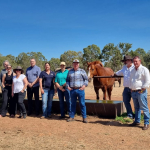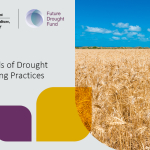Alice Springs, Australia – The Northern Hub is pleased to announce the completion of earthworks on a collaborative project to restore the natural functions of central Australian rangeland catchments. With El Nino looming, this transformative initiative aims to enhance ecological resilience through landscape rehydration and sustainable management practices.
Mike Clark of Top End Conservation Management, who manages the project, expressed his excitement for the project’s progress. “We’ve received enthusiastic support from Hewitt, who generously provided their properties at Narwietooma and Glen Helen for our work. Additionally, we’ve collaborated with the Central Land Council and the Anmatjere ranger team on desert rangelands, on Ahakeye Aboriginal Land Trust (Ti Tree Station).” Work also continued on Aileron Station where Landcare NT organised a large field day back in October 2021.
Willy Brown, the Narwietooma Manager with Hewitt, highlights the positive impact of the project. “It’s a win-win for everyone. Restoring the natural functions of the environment benefits not only the ecosystem but also enhances beef production due to increased grass availability.”
The critical role of funds from the Future Drought Fund is emphasised by specialists involved in the project. Scaling up efforts to cover tens of millions of hectares holds immense value. By greening up the landscape, a cooler and wetter environment can be created, potentially influencing rainfall patterns across the Australian interior and providing some control over the climate.
Lance Mudgway, a landscape rehydration specialist with The Mulloon Institute, explains the project’s approach of “slowing the flow” to retain moisture in the landscape. The establishment of leaky weirs in the creeks helps prevent downstream runoff and erosion by creating steps that hold water, dissipating its energy.
To further advance the project, the Northern Hub will hold a 1-day field day and half day contour grader school in September (13th and 14th on Narwietooma and Glen Helen Stations). Participants will have the opportunity to: see the finished landscape rehydration works on the properties; be introduced to the principles, planning and implementation of landscape rehydration; hone grader driving skills to build contour structures; and acquire knowledge about herd management practices to reduce overgrazing.
The initiative provides resources for: sub-catchment scale demonstrations; detailed analyses of rehydration works and controlled grazing on Woodgreen Station; and on-ground demonstrations of landscape rehydration, grazing and fire management. The project also facilitates workshops to support land managers in catchment function analysis, design for landscape rehydration and developing fire and grazing management plans.
The project spans multiple catchments, and includes Aileron, Ahakeye, Narwietooma, Glen Helen and Woodgreen Station. Successful rehydration efforts are expected to increase feed production during droughts and enhance resilience to erosion.
Rehydration works hold immense potential for restoring natural functions within the landscape, improving soil health, water infiltration and quality, reducing erosion and sedimentation, enhancing biodiversity, and increasing animal production. Additionally, it contributes to drought resilience, offers training opportunities for pastoral landholders, generates carbon credits, and enhances the natural capital in the Aileron region.


